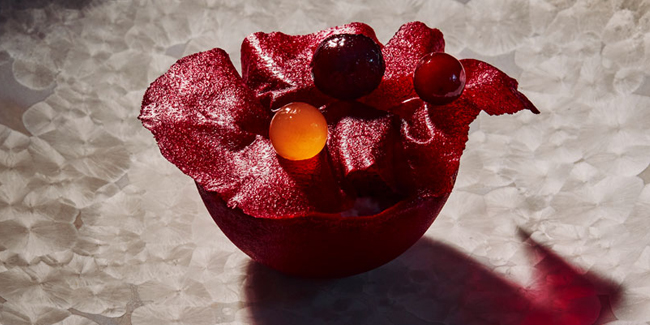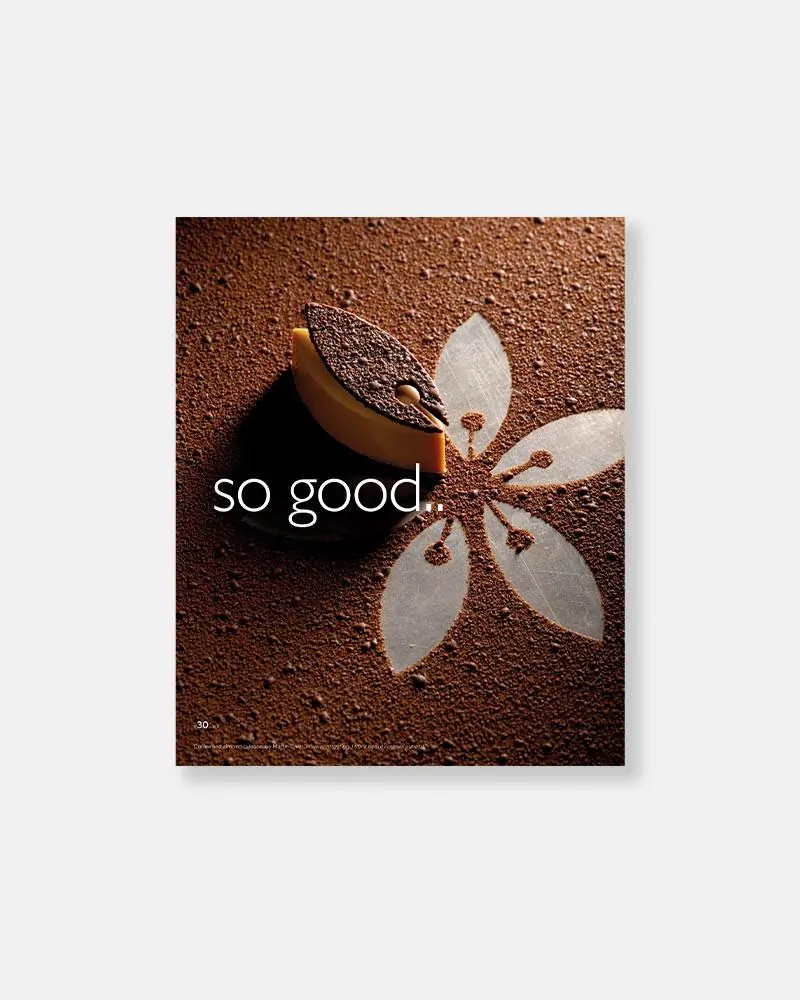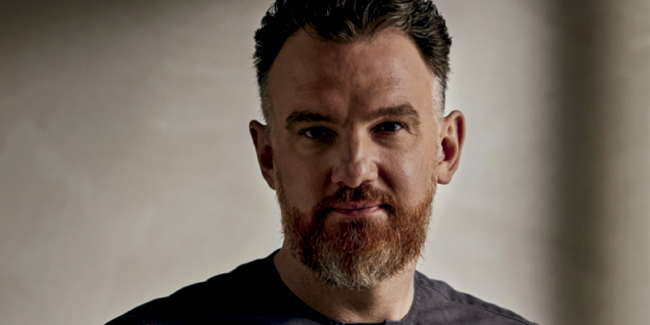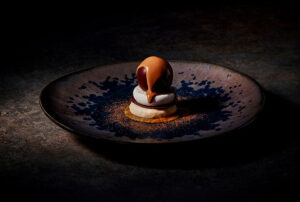Categories Pastry Chef Articles
René Frank: ‘We don’t add ingredients or garnishes just for beauty’
Why is it so hard for diners to value restaurant patisserie? It is common to find customers who pay less attention when the desserts arrive. For this reason, the profession of dessert chef needs the boost provided by figures such as René Frank. After managing the sweet station of the prestigious restaurant La Vie in Osnabrück (Germany), this restless professional opened in Berlin a space exclusively dedicated to desserts. The result of this commitment is CODA, a temple that already has two Michelin stars and where many of the dogmas that accompany restaurant patisserie are being reconfigured. As he himself defines in so good.. magazine 30, ‘we want to show guests that a dessert can be much more than just the final part of a menu.’ And to do so, he does not hesitate to build an experience that transcends sweetness to explore all flavors, umami included, and embrace all kinds of surprising techniques.
Photos: Claudia Goedke
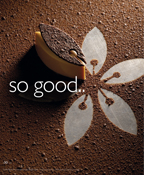
What prompted you to open a restaurant just focused on the world of desserts?
I come from a chef background. I am not a traditionally trained pastry chef and my last position before opening CODA was as head pastry chef at restaurant La Vie in Osnabrück. I worked there for six years as a pastry chef and was solely focused on desserts. When that chapter ended, I thought about my future and about combining what my focus for the last year had been, i.e. desserts, with what my dream was, i.e. to open a restaurant. That is how I came up with the idea of opening my own dessert restaurant. This happened without me actually knowing most of the details or how I would do it. Luckily, I found Oliver, my business partner and we slowly molded the vision into what it is today.
How would you define CODA’s experience?
CODA’s experience is a completely different one than the one from other restaurants and the best way to summarize it would be: we want to show our guests that a dessert can be much more than just the final part of a menu.
You have just updated CODA’s experience. What changes have you introduced?
My vision of CODA has been evolving during the last 7 years and we are always going to keep doing that. It is very important for me that we don’t stand still. The first stage, when we opened 7 years ago, was as a dessert bar. Then we had the recognition with the first and the second Michelin stars and we changed from bar to dessert restaurant. We still did two seatings during each service, doing the first one more like a restaurant service and the second one more like a bar service. Now we are going to focus on the restaurant service. We just started doing only one seating with an extended menu where we focus on that experience. We also changed the number of dishes from seven or eight to fifteen. We are excited about this new chapter and about all the possibilities that this new, longer menu opens.
As a chef and as a business owner, you really have to understand that you are as good as your team
After 7 years of trajectory, what lessons have you been most surprised to learn?
One of the biggest lessons I have learned is that as a chef and as a business owner you really have to understand that you are as good as your team. The team is the star of the restaurant. Everybody knows how important good products are and of course the food is extremely important, but you can achieve all that only with a great team of professionals around you. When I started seven years ago, I think I didn’t understand this fully.
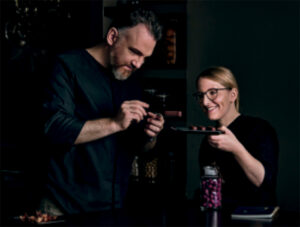
How is your creative process?
It starts with the season and continues with the feedback from our guests. But if I have to be more specific on my thought process, I start with an ingredient, let’s say a seasonal fruit or vegetable, and the second thing is the sweetening component of the dish. Can it be sweetened by the actual product or do we have to add sweetness to it with another ingredient? For us, the most important thing is the taste and flavor combination, so we always start with that, then comes texture and we finish with the visual side and the plating. Something important for me is that we don’t add ingredients or garnishes just for beauty. Every single component must make sense culinary-wise and add to the flavor, and everything must be edible.
Sweetness balance is an important part for you. Why?
If you think about it, everybody has a point for salt in their taste buds. Everybody has a point where they recognize if a dish is too salty or not and this is something which is also very important for sweetness and which not a lot of people recognize. We need to find that balance in the kitchen so that our desserts offer more to the experience than just a sweet overpowering punch. This is, for me, the most important thing to consider when you make a dessert. The second thing is to see the dessert in its context. Is it a part of a fifteen-course menu that you will have for dinner like at CODA? Or is it the last dish of a ten-course, let’s say traditional menu? The context changes everything and we have to consider that when we create a dessert.
How do you manage to balance a dessert menu with 15 dishes? What is important to have in mind while designing the menu?
When it comes to CODA, you have to consider that we offer a dinner menu, so our guests come on an empty stomach and want to leave on a full stomach. We have to look into textures, because if you have a dinner menu without nothing to chew or nothing crunchy that you have to use your teeth with, then you go home missing something. And we don’t want our guests to get home and eat some chips. Textures are key to a desserts menu. Then of course we need to include the five tastes throughout the menu. Sweetness, salt, acidity, bitterness and umami. Some of these flavors are not too common on desserts, especially umami, but we always find a way to incorporate them into our experience. We get some help from cheeses and fermented ingredients to achieve that.
Every single component must make sense culinary-wise and blend into the flavor, and everything must be edible
How can you design a dessert without having to include sugar, which plays an important technical role in some preparations such as ice creams?
First of all: everything that is sweet is sugar. It might come from a sweet potato or a grape, but it is sugar. What we don’t like nor use is white, processed and refined sugar. The same as a chef doesn’t want to use industrial processed MSG. But of course we need sugar to get that taste. It can be an unrefined cane sugar, honey, beetroot, or sugar achieved from fermentation… We have tons of ways. For preparations such as ice creams sugar is also a preservative and a stabilizer, and at CODA we don’t cook food that needs a long shelf life, we serve it immediately. If I make an ice cream at CODA, I serve it right away so it needs no stabilizer.
Then a lot of it comes from culture and tradition. Sugar has been a millenary method of preserving products, but we don’t need a lot of it anymore. I have access to all the fruits and vegetables every season, so I don’t need candied produce. The problem is that pastry is still mostly based on those traditional and ancient recipes and all of them have extremely high amounts of sugar. Our job is to change that through creativity and technique. You can stabilize an ice cream with starches or with fruit purée instead of sugar, for example. But also, an ice cream without sugar, to me, is not an ice cream. We make one with amazake, with koji fermented rice, for example. Another one with fermented oats and the sugar that we get naturally from that fermentation, plus a little bit of alcohol that also comes out of the same process, works as stabilizers for the ice cream and helps us achieve a very creamy texture.
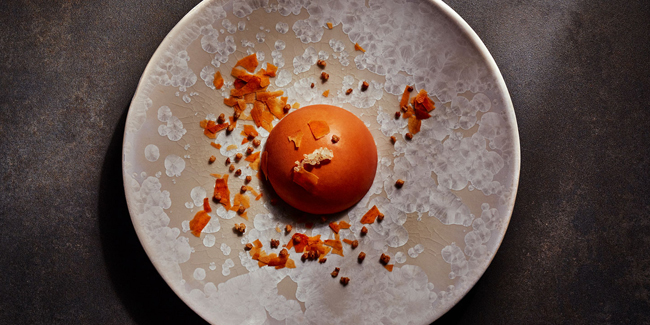
What lines of research are you currently focused on?
I am very focused on individual sugars at the moment. Especially in sugars that we can get naturally, for example the one we get out of fermented starch. If you ferment grains or rice with koji, the starch transforms into natural sweetness and then you have sweetness that basically comes out of nowhere. This is super interesting to me, and we are using it a lot at CODA right now. This is not a monosaccharide like glucose, which then goes super-fast into the blood and raises your blood sugar. These types of sugars that result from this fermentation process are oligosaccharides and are much healthier for us.
What are the limits when creating a dessert?
The bottom line is that there are no limits, but I always consider the context to create something that makes sense. If you are presenting a dessert to end a 10-course traditional menu, for example, then it is your job to offer a sweet dish that differentiates from the rest, a really different one. We can say that this would be a more traditional category of desserts. If you have a dessert-only menu, here comes the fun part, then there are no limits to what you can do with a dessert. Not every dish needs to be sweet. I do have some ethical limits. The biggest one would be not using any refined sugars, preservatives or chemicals. Then, another thing that I try to balance is the amount of animal produce. At CODA we use a very minimal amount of it, like bone marrow or caviar. But in general, if I am creating a dessert for a menu that includes a lot of fish and meat, I stay away from those products, for example if you want to use bacon on a dessert, or foie gras. I think that desserts must always be at the same level as all the other dishes, and if you ask a chef about the limits they would set on a snack, a starter or a main dish, they will probably say that there are no limits. They can use strawberries in a main dish or ice cream in a starter, but sometimes that freedom doesn’t seem to apply to pastry chefs. Why not?
Chefs can use strawberries in a main dish or ice cream in a starter, but sometimes that freedom doesn’t seem to apply to pastry chefs. Why not?
Beyond sweetness, what characterizes a dessert? What makes it different from the savory dishes in a menu?
The word dessert comes from the French language and in France and Europe, a dessert is defined as the dish that is served at the end of the menu. The table gets ‘deserved’ and then you serve the dessert. It must be something completely different from the rest of the menu. If you look around the world, this changes drastically. Every culture does this differently, so it is very difficult to define what characterizes desserts
for the whole world. I wouldn’t say that the key is its sweetness. To me what characterizes a dessert would be the textures and most importantly the emotions.
I truly believe that desserts spark a different kind of connection. A lot of them remind guests of their childhood, for example. Something that makes desserts different from traditional savory dishes is the technique and the texture. When we make savory desserts we always take those two factors into consideration. Like when we make the cheese waffle or the semi-baked cheesecake. If you pan fry a carrot or a piece of fish, and add a scoop of ice cream, that is of course not a dessert.
What products from the savory world have surprised you due to their versatility in the world of desserts?
Rice is super interesting. It is used in pastry as rice flour for example, or puffed rice, but when we started playing with koji and with fermentation, then a whole new world opened.
Why is it difficult for the customer to put desserts at the same level as the rest of the dishes in a menu?
Desserts have always been made with a lot of sugar but it is not an ingredient with a great value. More sugar doesn’t equal more quality. So this brings the value of our work down. I think that it is a valid question, the one that guests make: why should I pay a lot for a dish that is made of sugar, processed fruit paste, industrial chocolate, nut paste… I think that this might be one of the challenges for pastry chefs in the future. A dessert can be easily sold at the same price as a starter or a main course, because you sometimes put more or the same amount of work to cook or create a dessert than a main course, but we have to start bringing value to the ingredients that we use. Chefs don’t want to cook with a frozen fish, they want to get fresh fish, and we should also strive for those values as pastry chefs. Then the second part is to learn how to communicate that to our guests. If you use an organic egg instead of eggs out of a tetra brick, the flavor, quality and price of your dessert changes, but of course you need to communicate that to your guest. I think that they are willing to pay more for it if they know what they are getting. That is something which is natural in fine dining restaurants within the savory part, but we need to start doing it too.
Discover this recipe by René Frank in so good #30
